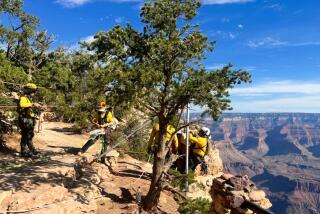Friends say O.C. man killed while BASE jumping embraced the risks
- Share via
Matthew Blank and Ian Flanders first met at a rock climbing gym in Orange County 10 years ago. They became fast friends and started climbing together at Yosemite National Park.
Adding to their adventures, they took up BASE jumping in 2008. The increasingly popular sport involves jumping from enormous heights off ridges and cliffs in a thrilling free-fall before releasing a parachute.
“Imagine the absolute freest activity you’ve ever done,” Blank said. “As soon as you leave the cliff, you have a feeling of total consciousness. Then speed.”
But the sport also has its obvious risks. On Tuesday, Flanders, 28, was killed in Kemaliye, Turkey, when his foot snagged in his parachute cords and he fell to his death.
Flanders is the third BASE jumper to die in as many months. Dean Potter, an internationally known jumper, and his friend Graham Hunt died in May after slamming into a mountainside in Yosemite moments after jumping off a 1,500-foot ridge outfitted in inflatable wing suits.
“People won’t stop dying from BASE jumping,” said Flanders’ friend Sean Chuma, who participated in a wing-suit dive in Flanders’ honor the day after his death. “People won’t stop dying in traffic, either.... It’s totally worth it to me, and it was totally worth it for Ian.”
Hours before his death, Flanders sat on a chairlift suspended by cables stretched between two cliffs. A river curled around a rocky shore 900 feet below.
Flanders, Blank and two others had scouted the jump the day before, checking weather conditions and wind speeds to minimize the risk. After a 90-minute hike to the “exit point” — the BASE jumper’s term for a launch site — the group used lasers to double-check height calculations. It was a beautiful day.
One by one, the four men stood up on their chairlift seats and jumped into the void between the mountain walls of the canyon. It was the first round of wing-suit jumps ever attempted in Turkey.
They spread their arms and the suits’ fabric unfurled along their upper bodies, catching the air and slowing their descent. When the first man landed in the river and made it safely to a rescue boat waiting below, the next sprang off his chair to follow. Flanders took the third leap, followed by Blank.
At the bottom of the canyon, they enjoyed breakfast, chatted, then packed their gear and headed back up for another round of jumps. This is the recipe for a good day of BASE jumping: jump, rest, repeat.
On his third and final jump, Flanders stood up on his chairlift and turned his back to the canyon wall, Blank said. He purposefully fell backward into the open sky, tumbling through backflips for the first seconds of the drop. Then, mid-flip, he released his parachute.
But his foot snared in the bridle, a smaller piece of the chute that deploys to help pull the larger canopy out of its case. The parachute deployed, but one side was constricted by the tangled cords.
Blank watched from his suspended chair as his friend struggled to free his foot. The lopsided parachute set Flanders on a spinning course toward the ground. Eleven seconds passed. Blank jumped after him, but rescue crews were already pulling Flanders’ body out of the water when he landed.
Despite Flanders’ death, his friends said they would keep seeking out new jumps.
“The reason people do this is because it’s a really deep passion,” Chuma said. “It certainly was for Ian. It’s something you keep doing, not like an addiction but like a celebration of life.... But you always understand what could happen.”
Flanders made his final wishes known before he took his last leap into the space between the sky and ground. He wanted his friends to take another trip to Yosemite to release his ashes over the edge of Half Dome. He wanted to take one last jump.
[email protected]
Twitter: @katemshepherd
NEWSLETTER: Get essential California headlines delivered daily >>
ALSO:
Should BASE jumping be a crime?
Why do extreme athletes like Dean Potter risk their lives?
Watch Dean Potter’s most high-profile jumps and climbs
More to Read
Get the Latinx Files newsletter
Stories that capture the multitudes within the American Latinx community.
You may occasionally receive promotional content from the Los Angeles Times.






